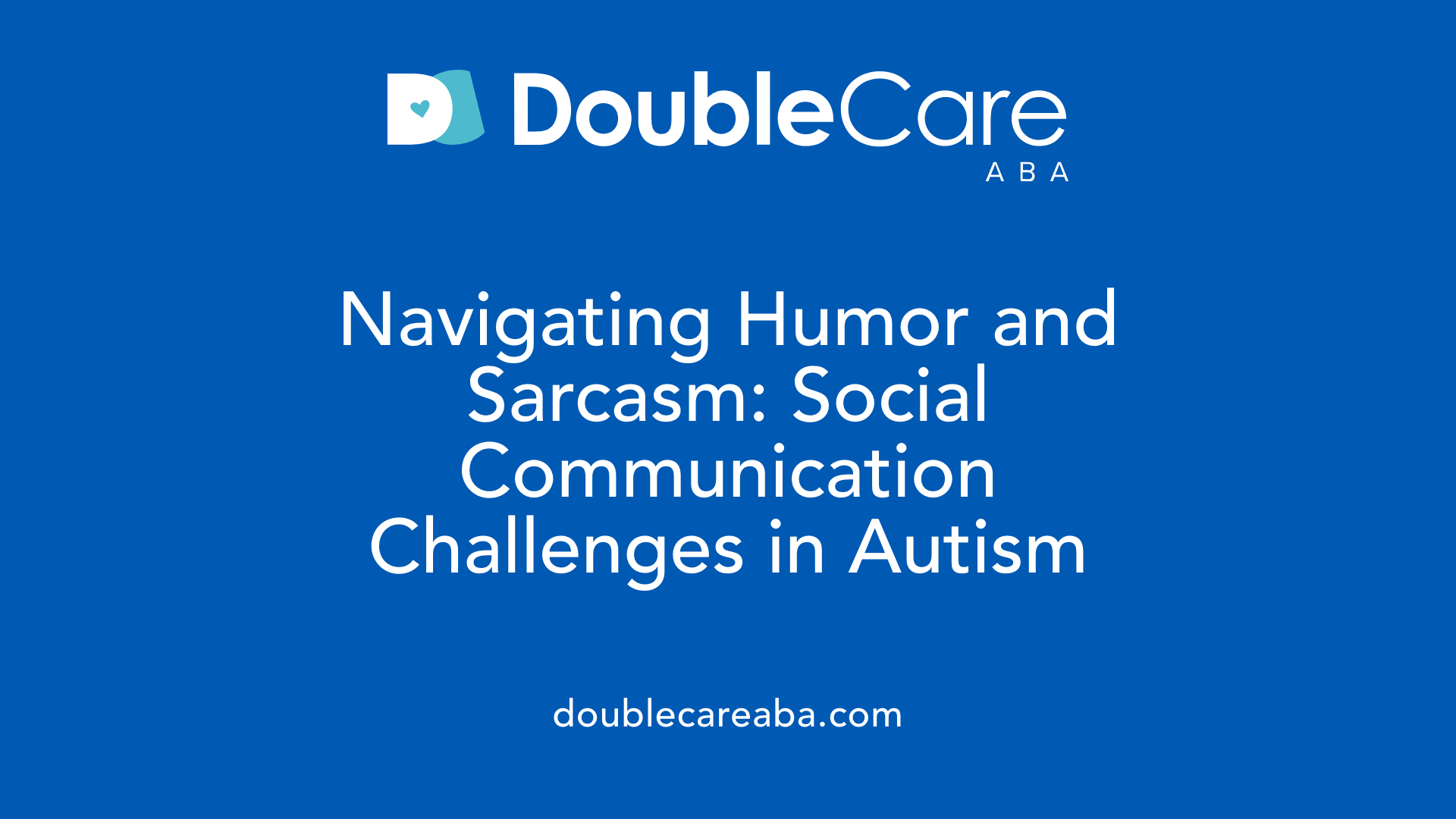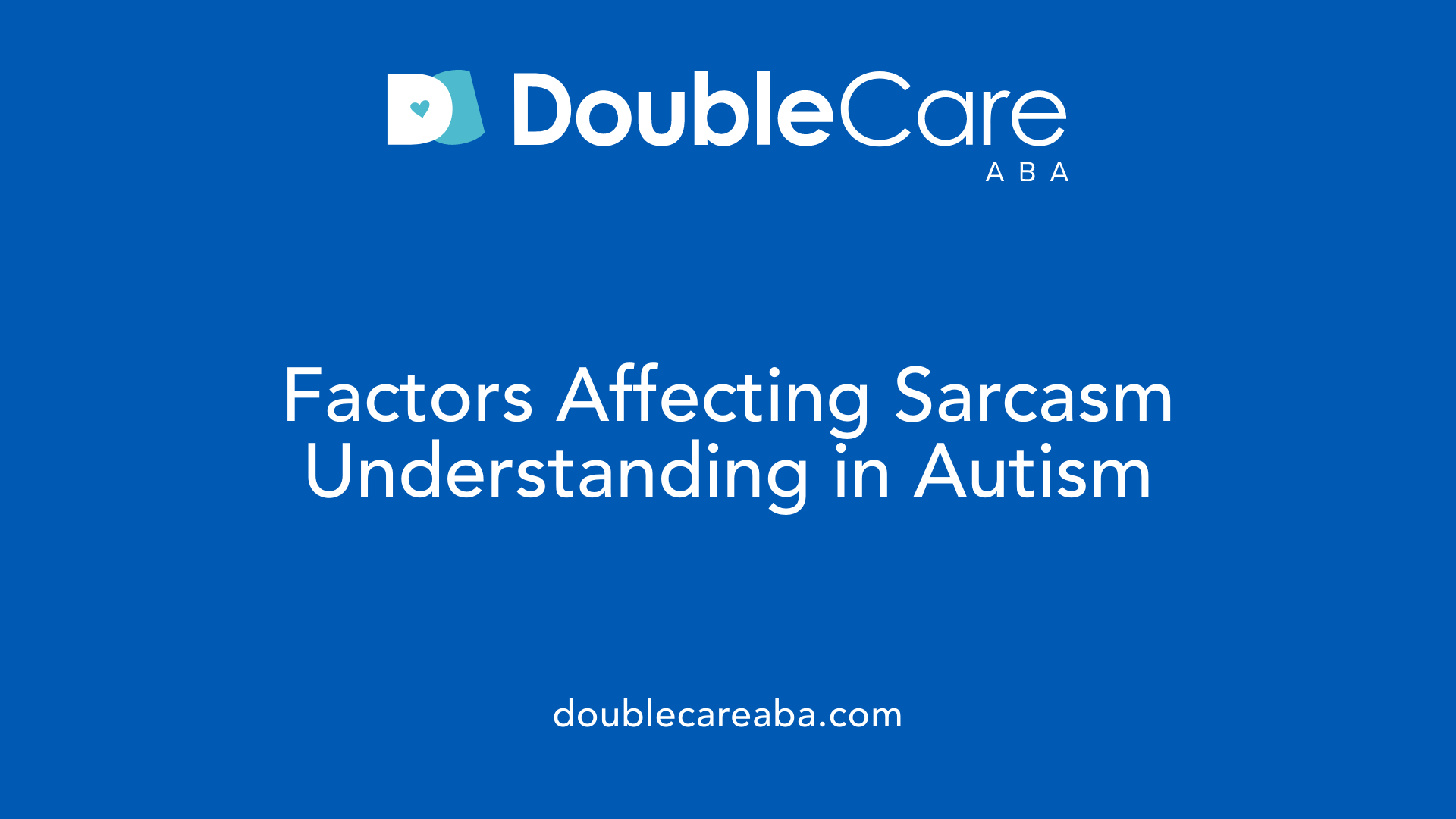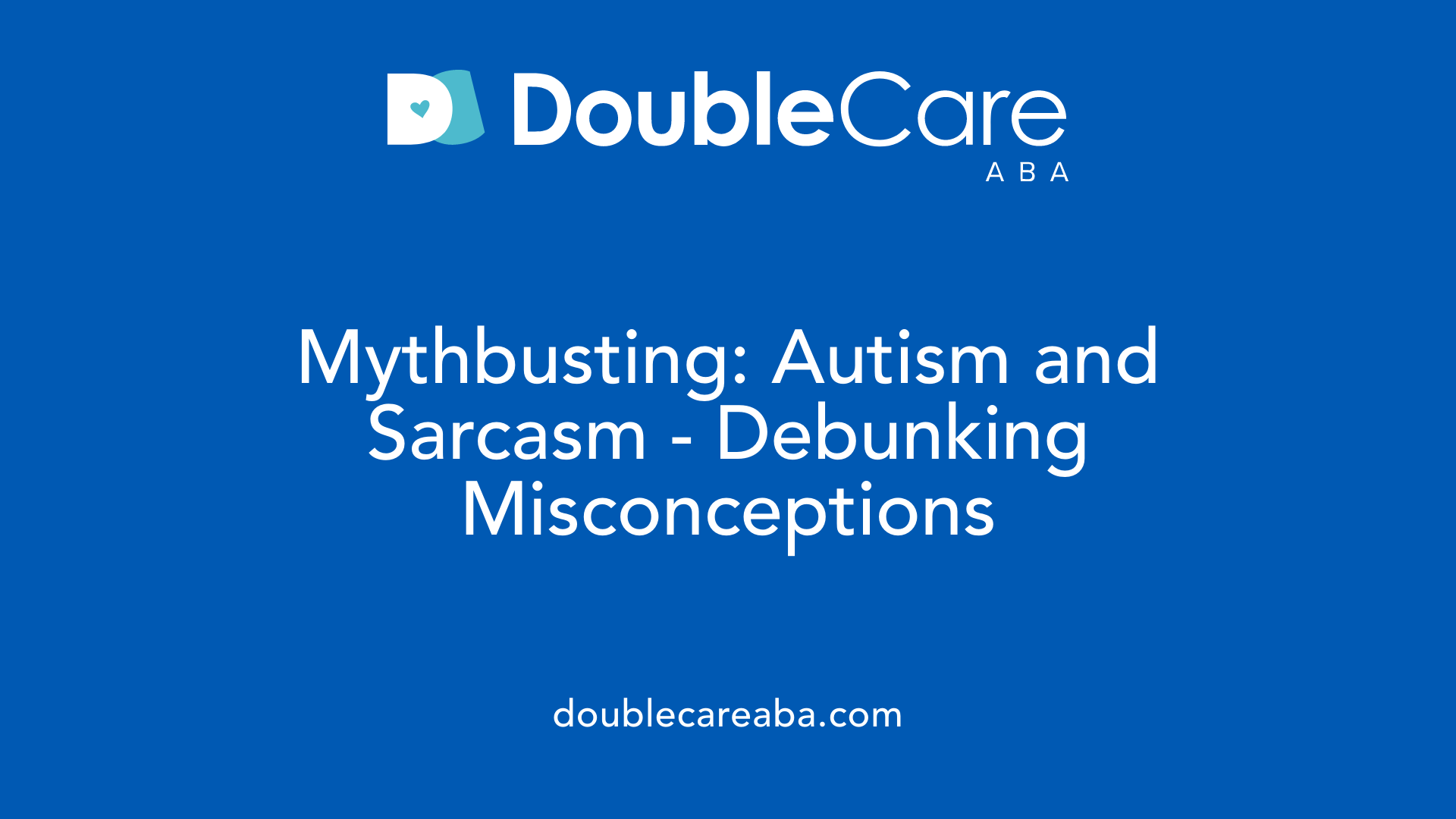Do Autistic People Understand Sarcasm?
Unraveling the Social Nuances of Autism and Sarcasm

Understanding the Intersection of Autism and Social Communication
The ability to understand sarcasm, humor, and figurative language is a complex aspect of social communication that often presents unique challenges for autistic individuals. While some may navigate these social nuances effectively, many others experience difficulties stemming from differences in processing non-verbal cues, tone, and contextual information. This article explores the nature of these challenges, the cognitive and social factors involved, and strategies to support autistic individuals in interpreting sarcasm more accurately.
Literal Thinking Patterns in Autism and Their Impact on Figurative Language

What are common literal thinking patterns in autism that may affect understanding of figurative language?
Many autistic individuals tend to interpret language very literally. This means that idiomatic expressions and figurative language, like "Break a leg" or "Hit the books," can be confusing because they are not meant to be taken at face value. Instead, these phrases often have implied or cultural meanings that require social understanding.
Autistic people may find it easier to understand direct, straightforward communication. When faced with sarcasm, satire, or humor that relies on social cues and double meanings, they often struggle. For example, humor that is dry or slapstick might be more accessible because it does not require interpreting complex non-verbal cues.
This literal approach can lead to misunderstandings in social interactions. For instance, a sarcastic comment or ironic remark might be taken seriously, causing confusion or unintended offense. Furthermore, interpreting non-verbal cues such as body language, tone of voice, and facial expressions is challenging. These cues are often vital to grasping the implied meaning behind figurative language.
Understanding these cognitive patterns is essential for developing better communication strategies. Using clear, direct language and providing concrete explanations can help autistic individuals navigate social and figurative language more effectively. Recognizing that literal thinking is a typical trait among many on the autism spectrum allows friends, family, and educators to foster more inclusive and understanding interactions.
Challenges in Social Communication: Humor and Sarcasm

What are some challenges autistic individuals face in social communication, especially regarding humor and sarcasm?
Autistic individuals often encounter difficulties in understanding humor and sarcasm because they typically interpret language in a literal way. This means they may struggle to recognize when someone is being sarcastic or joking, as these forms of communication rely heavily on tone of voice, facial expressions, and non-verbal cues.
Interpreting sarcasm requires understanding more than just words. It involves grasping social expectations, cultural norms, and the speaker’s intent — elements that can be confusing for autistic people. For example, a sarcastic comment is often delivered with a specific tone or facial expression that signals the speaker’s playful or ironic intent. Since autistic individuals may find it hard to process these cues, they can misinterpret or miss the sarcasm altogether.
Research indicates that factors such as deficits in Theory of Mind—the ability to understand others’ thoughts and feelings—and challenges with pragmatic language skills further hinder sarcasm comprehension. They also often focus on specific details rather than the broader context, making it harder to pick up on humor or irony.
This misinterpretation can lead to misunderstandings in social situations, feelings of loneliness, and frustration. It may even cause autistic individuals to feel ashamed if they are unable to interpret or respond to sarcastic remarks correctly.
Support strategies like visual aids, explicit teaching about social cues, and practicing in real-life scenarios can be helpful. Providing clear, straightforward explanations and using explicit cues, such as emojis or punctuation, can also assist in understanding sarcasm. Over time, with targeted social skills training and increased familiarity with social patterns, many autistic individuals improve their ability to recognize and use humor and sarcasm effectively.
Misunderstandings of Sarcasm and Their Prevalence

Are misunderstandings of sarcasm common among autistic individuals?
Yes, misunderstandings of sarcasm are quite common among autistic individuals. This is mainly because of difficulties in social perception and pragmatic language skills that are typical in autism. Many autistic people struggle with perceiving tone of voice, facial expressions, and body language — all crucial cues for recognizing sarcasm.
Research shows that children with autism often find it harder to understand figurative language, including sarcasm, compared to their neurotypical peers. These challenges can lead to miscommunications, social awkwardness, and misunderstandings with friends and family.
The reasons behind these difficulties include deficits in Theory of Mind—the ability to understand others' thoughts and intentions—and challenges in processing social and contextual cues. As a result, autistic individuals might interpret sarcastic remarks literally, missing the speaker's intention.
Despite these challenges, studies indicate that with targeted interventions—such as social skills training, explicit teaching, and visual supports—many autistic individuals can improve their understanding of sarcasm. This progress helps reduce social missteps and fosters more meaningful interactions.
Some autistic people can recognize sarcasm better when it is expressed in familiar contexts or by people they know well. Over time and with practice, their ability to interpret sarcasm may become more accurate, making social interactions smoother.
| Factor | Impact on Sarcasm Understanding | Additional Notes |
|---|---|---|
| Social Perception | Difficulties in reading social cues | A core challenge in autism affecting understanding non-verbal signals |
| Theory of Mind | Struggles to infer others' intentions | Essential for interpreting sarcasm as non-literal language |
| Processing Speed | Slower recognition of cues | Can cause delays or failure to catch sarcastic tone |
| Cognitive Flexibility | Rigidity in interpretation | Limits adaptation to non-literal language like sarcasm |
By understanding these factors, caregivers and educators can better support autistic individuals in developing sarcasm comprehension skills, facilitating improved social interactions and reduced misunderstandings.
Understanding Sarcasm and Humor: Variability in Autistic Experiences
Do autistic individuals understand sarcasm and jokes?
Many autistic people find it challenging to recognize sarcasm and jokes because of differences in processing social cues and language. They often interpret statements literally and may struggle with understanding tone, context, and non-verbal signals such as facial expressions and body language.
Research indicates that there are no consistent speech patterns that signal sarcasm, making it harder for autistic individuals to distinguish these remarks from genuine statements. This difficulty can lead to misunderstandings in social interactions, sometimes resulting in feelings of confusion, isolation, or frustration.
Autistic people’s ability to grasp humor, including sarcasm, varies widely. Some with higher verbal and social skills, or those who are familiar with a speaker’s habits and patterns, may recognize and use sarcasm effectively. For example, knowing someone’s communication style can help interpret their tone and cues more accurately.
Interventions such as social skills training, explicit instruction on understanding cues, and the use of visual supports can help improve comprehension. Clarification of sarcastic remarks, along with practice and contextual explanations, can support autistic individuals in navigating humor and social cues.
While many autistic individuals face challenges with sarcasm, it’s important to recognize the diversity within this community. Some are capable of understanding and employing sarcasm, especially when it is more obvious or explicitly marked. Overall, understanding sarcasm and humor in autism depends heavily on individual cognitive abilities, language skills, and social experiences.
Factors Influencing Sarcasm Comprehension in Autism

What factors influence an autistic person's ability to understand sarcasm?
Understanding sarcasm can be challenging for many autistic individuals because it involves interpreting tone, facial expressions, and other non-verbal cues—elements that are often difficult for them to perceive and process.
One of the primary factors affecting sarcasm comprehension is difficulty with the Theory of Mind (ToM). This cognitive skill helps people understand that others have different thoughts, feelings, and intentions. When ToM is impaired, recognizing that a speaker’s words are not meant to be taken literally becomes much harder.
Pragmatic language skills, which include the ability to use language effectively in social contexts, also influence understanding sarcasm. Many autistic individuals have trouble grasping the implied meanings behind sarcastic remarks, especially when language is figurative or ironic.
Processing speed and cognitive flexibility further impact one's ability to interpret sarcasm. Fast processing helps in catching subtle cues and responding appropriately, while cognitive flexibility enables shifting between literal and non-literal meaning.
Exposure to social situations contributes as well—those who have more experience with varied social interactions tend to recognize and understand sarcasm better. However, without explicit instruction or cues, many autistic individuals find it difficult to accurately interpret sarcasm.
Support strategies like social skills training, visual aids, and explicit teaching can make a significant difference. When sarcasm is made more obvious through tone, facial expressions, or contextual clues, it becomes easier for autistic individuals to comprehend.
Overall, the ability to understand sarcasm in autism varies widely among individuals, influenced by cognitive, linguistic, and social factors. Supportive interventions can help bridge the comprehension gap and improve social interactions.
Support Strategies for Improving Sarcasm Recognition
Are there strategies to support autistic individuals in understanding sarcasm?
Yes, there are several effective methods to help autistic individuals better understand sarcasm. One fundamental approach is providing explicit instruction about sarcastic language, which involves explaining what sarcasm is and highlighting its typical indicators.
Practicing interpretation skills is also essential. This can be done through role-playing exercises that simulate sarcastic exchanges, allowing autistic individuals to observe and respond to various cues. Social skills training programs often incorporate these activities, focusing on recognizing tone of voice, facial expressions, and body language.
Using visual aids, such as pictures, charts, or video clips, can make non-verbal cues more accessible. These supports help learners connect facial expressions and gestures with sarcastic intent, which might otherwise be missed.
Moreover, emphasizing context is crucial. Teaching individuals to pay attention to situational clues and using inference helps them understand sarcasm in everyday interactions. Clear aims such as routine practice and providing feedback encourage gradual improvement.
Creating a supportive communication environment is equally important. This involves patience from conversation partners, routine opportunities to practice, and open dialogue. Encouraging questions for clarification—like asking, "Are you being serious or joking?"—can reduce confusion.
In summary, combining direct education, visual aids, social skills training, and a supportive environment helps autistic individuals interpret sarcasm more accurately. This multi-faceted approach can diminish misunderstandings and foster more confident social interactions.
Mythbusting: Autism and the Perception of Sarcasm

Clarification that not all autistic individuals find sarcasm difficult.
While many autistic people struggle with understanding sarcasm due to differences in processing social cues, tone, and non-verbal cues, it is important to recognize that this is not true for everyone. Some autistic individuals are capable of understanding and even using sarcasm effectively, especially when they are familiar with a person's patterns and habits. Their experiences of humor and sarcasm are diverse, influenced by individual cognitive abilities, language skills, and social experiences.
Understanding sarcasm involves interpreting subtle cues such as tone of voice, facial expressions, and contextual hints. For autistic individuals, deciphering these non-literal language forms can be challenging because of differences in brain function, including theory of mind—which is the ability to understand others’ mental states—and pragmatic language skills.
However, with the right support, such as explicit teaching, visual supports, and contextual cues, many autistic individuals can improve their understanding of sarcasm. Some may require more obvious cues like emojis or clear markers to recognize sarcasm, especially in written text.
Cultural and individual differences also play a role. For example, familiarity with a person’s habits and speech patterns can help some autistic people interpret sarcasm better. Conversely, when sarcasm is subtle or expressed through complex non-verbal signals, understanding becomes more difficult.
In summary, the ability to process sarcasm varies among autistic individuals. It is influenced by factors such as cognitive abilities, social experience, and support systems. Recognizing this diversity helps foster greater understanding and encourages inclusive communication strategies.
Supporting Social Understanding in Autism
In conclusion, the ability of autistic individuals to understand sarcasm varies widely and is influenced by numerous cognitive, social, and experiential factors. While many may find interpreting sarcasm challenging due to literal thinking patterns, difficulties recognizing non-verbal cues, and deficits in theory of mind, targeted strategies like explicit instruction, visual supports, and social skills training can significantly enhance comprehension. Recognizing that understanding sarcasm is a learned social skill, not a reflection of intelligence, is crucial in fostering an inclusive and supportive environment. These efforts can help reduce misunderstandings, promote social bonding, and empower autistic individuals to navigate social interactions more confidently.
References
- Autism and Sarcasm: Navigating the Challenges
- Can Autistic People Understand Humor and Sarcasm?
- Can Autistic People Understand Sarcasm? - Neurodivergent Rebel
- Do Autistic People Understand Sarcasm? - Astra ABA
- Can Autistic People Understand Humor and Sarcasm?
- Why Not Understanding Sarcasm Can be such a 'Big Deal' - ibcces
- Autism and Sarcasm: Navigating the Challenges
- Can an Autistic Person Understand Sarcasm? - Golden Care Therapy
- Do Autistic People Understand Sarcasm? - Astra ABA
- Sarcasm and Autism: The Ultimate Guide - Number Analytics
















